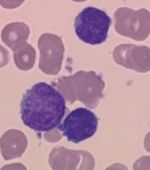Inotuzumab Ozogamicin Achieves ‘Markedly Long’ Antitumor Response in Indolent B-Cell NHL
Inotuzumab ozogamicin has achieved a markedly long antitumor response in patients with refractory or relapsed indolent B-cell non-Hodgkin lymphoma (NHL) in an ongoing phase II study. Interim findings were reported by lead investigator Kenneth Luu, PhD, associate director of Pfizer global R&D.
CHICAGO-Inotuzumab ozogamicin has achieved a markedly long antitumor response in patients with refractory or relapsed indolent B-cell non-Hodgkin lymphoma (NHL) in an ongoing phase II study. Interim findings were reported by lead investigator Kenneth Luu, PhD, associate director of Pfizer global R&D.

Inotuzumab ozogamicin has achieved a markedly long antitumor response in patients with refractory or relapsed indolent B-cell non-Hodgkin lymphoma. Image source: Thieblemont C, et al.
Splenic Marginal Zone Lymphoma: Current Knowledge and Future Directions
.
Oncology
. 2012;26:194-202.
Inotuzumab ozogamicin is an investigational antibody-drug conjugate composed of a monoclonal antibody that targets CD22, a cell surface antigen expressed on approximately 90% of B-cell malignancies linked to a cytotoxic agent. When inotuzumab ozogamicin binds to CD22 it is absorbed into the cell, inducing release of the cytotoxic agent calicheamicin.
The aim of the study is to evaluate the antitumor activity of inotuzumab ozogamicin by performing pharmacokinetic-pharmacodynamic (PK-PD) modeling of drug concentrations and tumor size (as determined from the sum of products of diameters). Inotuzumab ozogamicin was administered 1.8 mg/m2 intravenously once every 28 days for a planned 4 to 8 cycles to patients whose indolent B-cell NHL was refractory to rituximab.
Analysis was performed with a set of 28 patients with indolent NHL (24 follicular, 2 small lymphocytic lymphoma, 2 marginal zone) having assessable data at the interim stage of the study. Population PK-PD modeling was conducted using NONMEM version 7.1.2 (a nonlinear mixed effects modeling software). Longitudinal tumor size data included measurements from the prescreen time, during treatment with inotuzumab ozogamicin, and up to 15 months of follow-up.
The PK of total calicheamicin was described by a linear 2-compartment model. Tumor size (T) was described by an exponential net growth (kgr) model with an inhibitory drug effect (slope) on kgr and drug concentration (Cp), such that dT/dt = kgr(1-slope x Cp)T.
Of 28 subjects evaluated, 18 exhibited tumor shrinkage (maximum reduction from baseline with a range of 12% to 100%; median 68%), among which 10 were progression free/without tumor regrowth ranging from 10 to 18 months after the first dose. “Tumor shrinkage was seen as early as 54 days post treatment-initiation, with peak tumor shrinkage as early as day 103,” said Dr. Luu.
The population estimates of clearance (CL), central (V1), peripheral (V2) volumes of distribution, and intercompartmental clearance (Q) were 2.69 (±0.41) L/day/m2, 30.4 (±1.79) L/m2, 90.9 (±19.8) L/m2 and 5.50 (±1.29) L/day/m2, respectively. The population parameter estimates of the PD model were 9.41 × 10-4 (±5.33 × 10-4) day-1 for kgr and 0.396 (±0.178) ng/mL-1 for the slope. Simulations from the model using 1,000 virtual subjects (1.8 mg/m2 every 28 days for a total of 4 cycles) showed that the median 10% tumor shrinkage can be seen as early as 35 days, with peak suppression occurring as early as 161 days. In addition, reported Dr. Luu, the duration of response was sustained beyond 1 year post-treatment, and the tumor size does not return to baseline for up to 2 years after the first treatment.
“Antitumor response to inotuzumab ozogamicin was characterized by a markedly long duration of response,” said Dr. Luu. “PK-PD modeling improved the quantitative understanding of the time course of tumor size relative to inotuzumab treatment. The model, with updated data from the ongoing study, has utility in optimizing the dose and treatment regimen for subsequent follow-up studies in indolent lymphoma.”
Pfizer is exploring a clinical development program to determine which patients may benefit from inotuzumab ozogamicin in different B-cell malignancies. A phase III trial called INO-VATE is currently enrolling patients with aggressive NHL who are not candidates for intensive high-dose chemotherapy. And another phase II study is investigating inotuzumab ozogamicin in patients with relapsed/refractory CD22-positive diffuse large B-cell lymphoma, eligible for autologous stem cell transplantation.
“This study demonstrates clinically meaningful tumor responses for patients with rituximab-resistance indolent lymphoma,” commented Douglas Stewart, MD, FRCPC, chief of the division of hematology and hematological malignancies at the University of Calgary, and provincial leader of the hematology tumor team of Alberta Health Service Cancer Care, Calgary, Alberta, Canada. “Phase III trials results are eagerly awaited to determine the potential role of this new lymphoma therapy.”